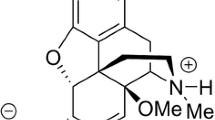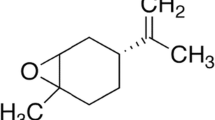Abstract
The study examined the potentiation of the antinociceptive action of opioid analgesics produced by gaseous superoxide (GS) in the rat hind paw withdrawal test (PWT) and by GS or hydrogen peroxide (HP) in the formalin test. In the PWT, inhalation of GS for 50 minutes before i.p. injection of threshold doses of morphine (0.5mg/kg) and trimeperidine (1.0 mg/kg) increased the threshold of nociception (TN) by a maximum of 43.0% (p<0.05) and 113.4% (p<0.01) respectively. The GS/trimeperidine-dependent increase in TN showed two peaks, the second of which could be suppressed by nialamide. Naloxone abolished the GS/morphine-dependent increased in the TN. In the formalin test, a significant antinociceptive effect developed after GS inhalation or HP administration (intranasally, 2×5μl of 2×10−5 mol/l solution in saline) in combination with low doses of Omnopon (0.06–0.75 mg/kg). These results suggest that both GS and HP potentiate the antinociceptive effects of opioid analgesics.
Similar content being viewed by others
References
Fridovich I. Superoxide radical: an endogenous toxicant. Annu Rev Pharmacol Toxicol 1983;23:239–57.
Dolezalek H. Remarks on the physics of atmospheric ions (natural and artificial). Int J Biometeorol 1985;29:211–21.
Goldstein NI, Goldstein RN, Merzlyak MN. Negative air ions as a source of superoxide. Int J Biometeorol 1992;36:118–22.
Olivereau J.-M.. Incidences psychophysiologiques des facteurs climatiques de l'environment. Bulletin de Psychologie (Paris) 1971;24:597–606.
Krueger AP, Sigel S. Small air ions, as biologically active agents. In: König HL, Krueger AP, Lang S, Sönning W, editors. Biologic Effects of Environmental Electromagnetism. New York: Springer, 1981: 144–75.
Gilbert GO. Effect of negative air ions upon emotionality and brain serotonin levels in isolated rats. Int J Biometeorol 1973;17:267–75.
Hawkins LH, Morris L. Air ions and the sick building syndrome. vol 1. In: Berglund B, Lindvall T, Sundell J, editors. Proceedings of the 3rd International Conference on Indoor Air Quality and Climate. Recent Advances in Healt Sciences and Technology. Stockholm: Swedish Council for Building Research, 1984: 197–200.
LeBars D. Serotonin and pain. In: Osborne NN, Hamon M, editors. Neuronal Serotonin. Chichester: John Wiley, 1988: 171–229.
Murphy AZ, Murphy RM, Zemlan FR. Role of spinal serotonin1 receptor subtypes in thermally and mechanically elicited nociceptive reflexes. Psychopharmacology 1992;108: 123–30.
Basbaum AI, Fields HL. Endogenous pain control systems: brain stem spinal pathways and endorphin circuity. Annu Rev Neurosci 1984;7:309–38.
Möse JR, Fischer GP, Weiss AM, Huter E. Positive and negative ions influence on the activity of the adrenal cortex. Zbl Bact Hyg I. Abt Orig B 1976;161:377–82.
Minehart JR, David TA, McGurk FJ, Kornblueh IH. The effect of artificially ionized air on post-operative discomfort. Am J Phys Med 1961;40:56–62.
Olivereau J.-M., L'ionisation atmosphérique et ses conséquences sur le comportement des animaux et de l'homme. Année Psychol 1976;76:213–44.
Beardwood CJ, Jordi PM. Effect of negative air ions on morphine-induced changes in the latency of the tail-flick reflex. Bioelectromagnetics 1990;11:207–12.
Polgar P, Taylor L. Stimulation of prostaglandin synthesis by ascorbic acid via hydrogen peroxide formation. Prostaglandins 1980;19:693–700.
Flohé L, Giertz H, Beckmann R. Free radical scavengers as anti-inflammatory drugs? In: Bonta IL, Bray MA, Parnham MJ, editors. Handbook of Inflammation. Vol. 5. The Pharmacology of Inflammation. Amsterdam: Elsevier, 1985;5:255–74.
Kress M, Riedl B, Reeh PW. Effects of oxygen radicals on nociceptive afferents in the rat skin in vitro. Pain 1995;62:87–94.
Dubuisson D, Dennis SG. The formalin test: a, quatitative study of the analgesic effects of morphine, meperidine and brain-stem stimulation in rats and cats. Pain 1977;4:161–74.
Abbott FV, Franklin KBJ, Westbrook RF. The formalin test: scoring properties of the first and second phases of the pain response in rats. Pain 1995;60:91–102.
Goldstein NI. Air ions: The possible role of active oxygen species in mechanisms of biological action. In: Goldstein NI, editor. Oxygen Radicals in Chemistry, Biology and Medicine. [Russian]. Riga: Latvian Medical Academy, 1988: 80–108.
Kellogg EW, Yost MG, Barthakur N, Krueger AP. Superoxide involvement in the bactericidial effect of negative air ions onStaphylococcus albus. Nature 1979;281:400–1.
Saitsev AA. Pharmacological analyse of opioid- and adrenergic regulation mechanism of vascular nociceptive reactions. In: Anonymous, editor. Neuropharmacological regulation of pain sensitivity. [Russian] Leningrad: Nauka, 1984:53–74.
Jurna I. Dämpfung repetitiver Aktivierungsvorgänge an der spinalen Motorik durch Morphin. In: Janzen R, Keidel WD, Herz A, Steichele C, editors. Schmerz. Stuttgart: Thieme, 1972: 267–9.
Dennis SG, Melzack R. Pain modulation by 5-hydroxytryptaminergic agents and morphine as measured by three pain tests. Exp Neurol 1980;69:260–70.
Millan MJ. Kappa-opioid receptor-mediated antinociception in the rat. I. Comparative actions of mu- and kappa-opioids against noxious thermal, pressure and electrical stimuli. J Pharmacol Exp Ther 1989;251:334–41.
Author information
Authors and Affiliations
Additional information
accepted by K. Brune
Rights and permissions
About this article
Cite this article
Goldstein, N., Lewin, T., Kamensky, A. et al. Exogenous gaseous superoxide potentiates the antinociceptive effect of opioid analgesic agents. Inflamm Res 45, 473–478 (1996). https://doi.org/10.1007/BF02252319
Received:
Revised:
Accepted:
Issue Date:
DOI: https://doi.org/10.1007/BF02252319




